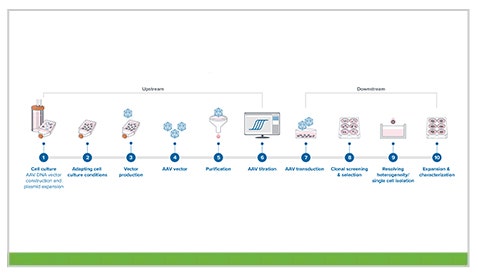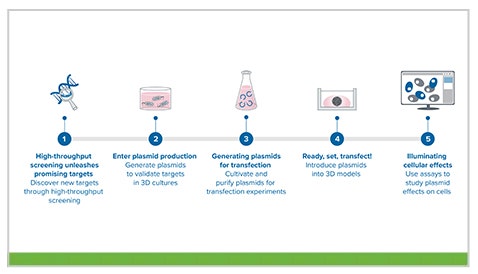What is a plasmid?
A plasmid is a small, circular DNA molecule distinct from chromosomal DNA, possessing the unique ability to replicate independently. Essential in molecular biology, plasmids facilitate the manipulation, study, and plasmid DNA production of genes. Molecular cloning, a technique used to produce identical copies of DNA fragments, is intrinsically linked to plasmid production. Plasmids serve as the vehicle to replicate these DNA fragments in bacterial cells. By introducing a gene of interest into a plasmid, researchers can produce large quantities of that gene for various applications, bridging gaps in our understanding of genetic coding.
Discover the pivotal link between plasmid production and drug development. As drug success rates hinge on accurate predictions, plasmids play a crucial role in efficient DNA delivery for gene therapies and vaccines, presenting safer and scalable solutions for addressing various diseases.
What are plasmids used for?
- Gene cloning: Widely recognized for their cloning capabilities, plasmids enable the duplication of specific genes. Introducing a gene of interest into a plasmid allows for its propagation within bacterial cells, producing large amounts of the desired genetic material.
- Expression vectors: Plasmids function as vectors, facilitating the expression of desired genes in a designated host cell. Once the gene of interest is integrated into the plasmid DNA molecule, it's introduced to the host, spurring gene expression.
- Gene editing: Leveraging plasmids for gene editing, like CRISPR-Cas9, ensures precision. The plasmid transports the necessary components for genetic modification, altering the host cell's DNA structure.
- Protein production: For large-scale protein production, plasmids encompass the requisite gene, prompting the host cell to generate the encoded protein.
- Drug Discovery: Integral to drug discovery, plasmids are vital carriers of therapeutic genes used in cell and gene therapy and mRNA vaccines. Efficient plasmid production is paramount to meet the surging market demands for treatments.

Anatomy of a bacterial cell showcasing its structure, where plasmids—small, circular DNA molecules—reside and replicate. This prokaryotic environment is fundamental for plasmid DNA production, a cornerstone in molecular biology and genetic research.
Molecular Cloning Workflow for Plasmid DNA Production

- Strategic Design - In the process of strategic design for cloning, the initial step involves optimizing the cloning strategy, including the selection of appropriate restriction enzymes and vectors, as well as designing primers for gene amplification, while simultaneously optimizing PCR conditions.
- Sample Prep - Subsequently, DNA sample preparation follows, encompassing tasks like DNA extraction, PCR gene amplification, and DNA fragment purification.
- Enzyme Digestion - Afterward, the DNA fragments undergo digestion by restriction enzymes, a process that can be automated with robotic pipetting systems.
- Ligations - These digested fragments are then ligated to a compatible vector using an automated ligation reaction, facilitated by systems like robotic pipetting or liquid handling robots.
- Transformation - The ligated DNA is subsequently transformed into competent cells via automated electroporation systems, using specialized equipment such as electroporators or microfluidic devices.
- Plating - The transformed cells find their place on selective media through an automated plating system such as the QPix® Microbial Colony Picker, promoting the growth of recombinant colonies.
- Picking and Screening - These colonies are then automatically picked and screened by our QPix® microbial colony picker.
- Sequencing – Clones passing the screening phase are subjected to automated DNA sequencing to affirm the successful cloning of the desired DNA fragment.
- Data Analysis - This sequencing data is then analyzed using automated software tools, which not only identify but also annotate the cloned DNA fragments and their sequences.
Discover our automated plasmid mini-prep bundle
Watch Rebecca Kreipke, our Field Application Specialist, demonstrate our plasmid preparation solution
This automated platform is designed for researchers aiming to streamline their plasmid preparation process. Perfect for achieving low to medium throughput with validated protocols, our entry-level automation setup has the potential to expand. Featuring:
- QPix® XE Microbial Colony Picker
- SpectraMax® i3x Microplate Reader
- Liquid Handler
- Shaking Incubator
- Robotic Arm
- Plate Hotel

AAV – PLASMIDS
Delve into the intricate AAV-plasmid workflow, a cornerstone in biomanufacturing. The Adeno-Associated Virus (AAV) stands out for its minimal replication and low human immunogenicity. This process covers everything from AAV DNA vector construction and plasmid expansion to the purification and transduction of mammalian cells. Discover the precision steps, from optimizing culture conditions to high-throughput clone screening.

From molecular cloning to 3D cell culture: Integrating plasmids production in organoid screening workflow
Plasmid production in 3D cell models is essential for gene function analysis. The process begins with bacterial cultivation and culminates in gene integration into 3D cultures. Through plasmids, researchers examine tissue morphogenesis, organoid growth, and potential therapeutic targets. This workflow offers profound insights into 3D tissue development and the nuances of biomedical research. Dive deeper for a detailed perspective.
Applications and methods for the plasmid DNA manufacturing
Latest Resources
Automated workflow for Plasmid Production
In plasmid DNA manufacturing, the target gene is key for molecular cloning efficiency. Our lab automation solutions enhance your plasmid cloning workflow, from DNA isolation to colony picking. We tailor plasmid production systems for current and future biotechnology needs. With expertise in molecular cloning techniques, we integrate top technology into your process. We provide ongoing support, ensuring alignment with evolving plasmid production demands.
